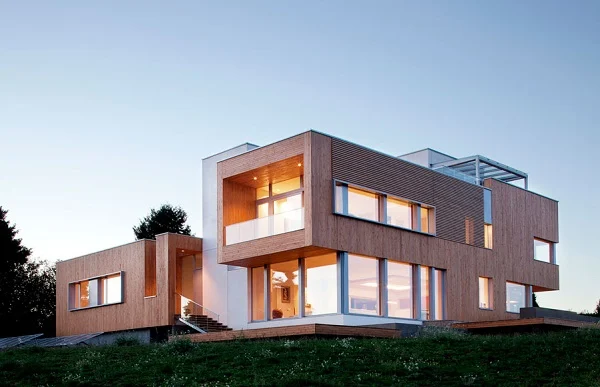Two years ago, we told you about a project unfolding in the wine country southwest of Portland, Ore., a net-zero home that was attempting to become the first in the world to earn a trio of green building performance standards – PHIUS+ Passive House, Minergie-P-Eco and LEED for Homes Platinum.
Mission accomplished.

image via Hammer & Hand
Builder Hammer & Hand, which worked with the firm Holst Architecture on the project, posted on its blog on Tuesday that Karuna House had earned a remarkable 101.5 LEED points, far outdistancing the 80 that it needed to take go Platinum. According to Hammer & Hand:
The news means that the project team achieved its goal: to tackle three of the world’s most demanding green building certifications in one project, all while building a great house. The project became a case study of green building certifications and technique.
Rather than even try to detail what makes Karuna House so amazing, we’ll just refer you to the case study on the Hammer & Hand site, which provides an in-depth look at its high-performance foundation system, wall assembly, windows and doors and mechanical systems, among other features.
But there is one thing that deserves highlighting here: The insights into green building standards that Hammer & Hand gained through the process of building Karuna House. We hear certification standards bandied about by contractors, architects, real estate companies and others, but do we really know what they mean? This analsyis, from Sam Hagerman, president of Hammer & Hand, and Skylar Swinford, energy analyst, provides tremendous insight. Quoting from the company’s blog:
LEED for HOMES PLATINUM
LEED has done a lot of things right. It addresses a broad range of sustainability goals and has brought green building to the industry and the market with impressive speed. But viewed through our durability-and-performance-first lens, LEED leaves too much wiggle room. In its attempt to be user friendly, LEED rewards a focus on the easiest green building “credits” rather than the most important. And while LEED offers several levels of certification, project teams have so many ways to reach those levels that energy performance and durability can easily get short shrift, even at Platinum level. The base levels of energy performance required by LEED are too modest and the tools that LEED relies on to predict energy performance can lead to overly optimistic energy projections. We could have built the Karuna House riddled with energy-draining thermal bridges and achieve the same LEED score as the actual, built project. But this Karuna doppelganger would have performed poorly and been far less durable due to moisture and condensation. LEED’s broad range of sustainability goals is laudable, but it misses on energy performance and durability.
PASSIVE HOUSE
Passive House is the opposite. It is entirely performance-based. Either a project hits the three performance targets of the standard (airtightness of 0.60ACH at 50 Pascals, 4.75 kBTU/ft2 annual heating and cooling demand, 38.1 kBTU/ft2 annual total primary energy demand) or it doesn’t. Blower door fan tests confirm airtightness performance. A modeling tool with high correlation between predicted and actual energy use predicts energy demand. And for PHIUS+ certification, a third-party verifies compliance to the standard through onsite inspection. As a building science-based approach, Passive House emphasizes the performance of building components and therefore can accurately predict both energy loads and the way that heat, air and moisture will impact the structure and its assemblies. So Passive House offers a direct path to building durability and energy performance. It does not, however, directly address broader sustainability goals, so other certifications like LEED can be a good complement.
MINERGIE
The Swiss certification, Minergie-P-ECO, aims for this complementary combination of energy performance focus (Minergie-P) and broad sustainability goals (Minergie-ECO). The “P” in Minergie-P stands for “passive,” and this portion of the standard closely mirrors Passive House, with its simple set of aggressive airtightness and energy demand targets. The “ECO” in Minergie-ECO refers to a broad set of ecological goals in building that require designers and builders to avoid toxic materials, de-emphasize assemblies that are complex and difficult to disassemble for future reuse, and specify materials and processes that protect installer health. Minergie-P-ECO is a powerful and comprehensive green building certification, though today certification cost and relative lack of operational infrastructure on this side of the Atlantic may slow adoption of the standard in the US. Karuna is the first Minergie-P-ECO project here.






